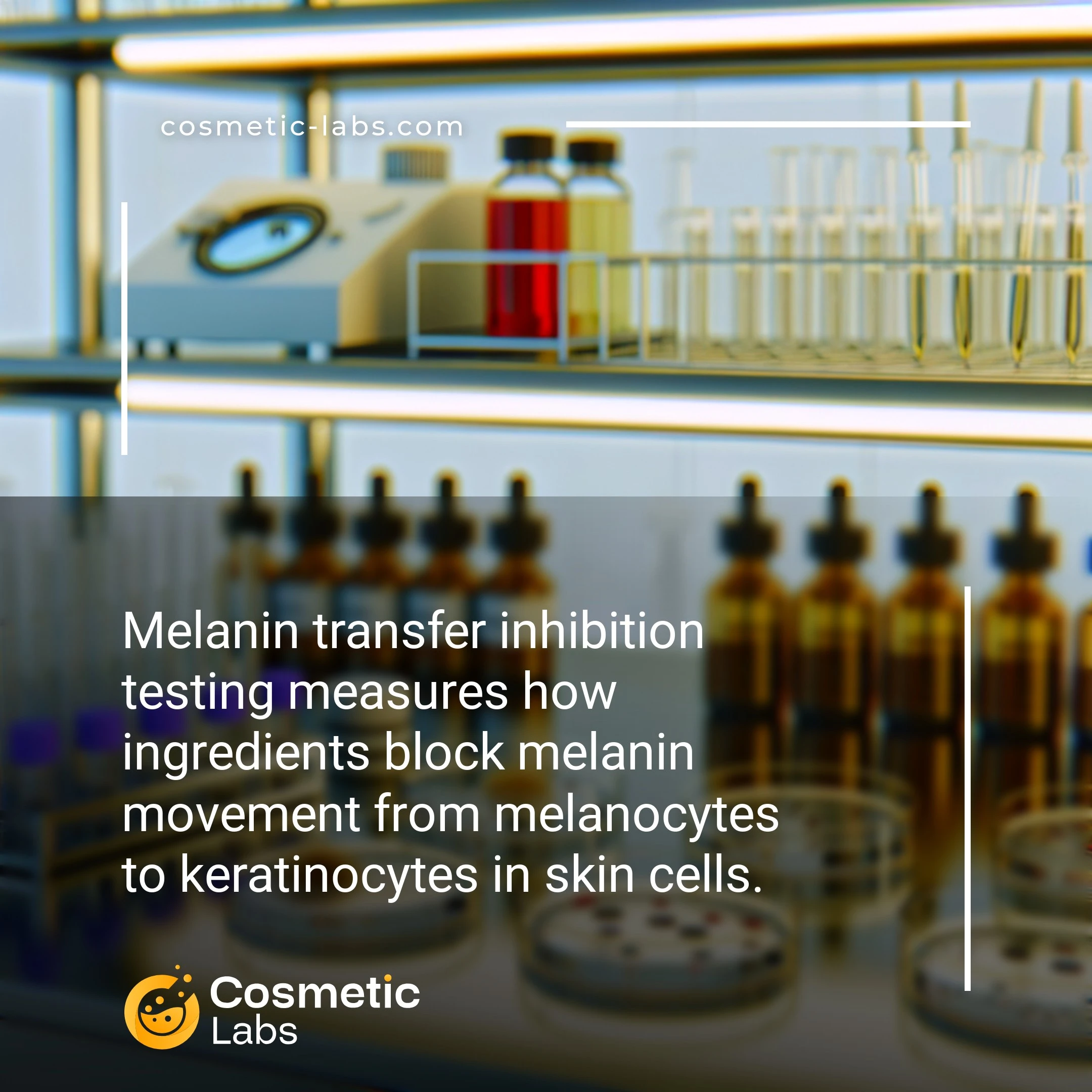Melanin Transfer Inhibition Testing for Cosmetic Brands

What is Melanin transfer inhibition testing?
Melanin transfer inhibition testing services evaluate how effectively cosmetic ingredients prevent melanin movement from melanocytes to keratinocytes in skin cells. Labs use in vitro co-culture models to measure ingredient performance, testing concentrations from 0.1% to 5% over 72-hour periods. This testing reveals whether your brightening actives actually block pigment transfer rather than just reducing melanin production, giving you precise data for product claims and regulatory submissions.
Why do you need this service?
Cosmetic brands leverage melanin transfer inhibition testing to validate brightening serums and spot-correcting treatments before market launch. Labs on our platform measure how effectively your formulations block melanin movement from melanocytes to keratinocytes, delivering quantifiable data for regulatory submissions and consumer claims substantiation within 2-4 weeks.
Who provides Melanin transfer inhibition testing services?
All cosmetic labs providing Melanin transfer inhibition testing services
There is no company providing these services at the moment.
Melanin Transfer Inhibition Testing Services
Melanin transfer inhibition testing validates how effectively your whitening and brightening formulations prevent melanin movement from melanocytes to keratinocytes. This specialized testing complements standard pigmentation efficacy assessments by measuring the cellular-level mechanisms that control skin tone regulation.
Co-Culture Cell Model Testing
Labs use melanin transfer inhibition assays with co-cultured melanocytes and keratinocytes to simulate natural skin pigmentation processes. These models expose cells to your active ingredients at various concentrations, then measure melanin content in keratinocytes after 72-96 hours of treatment.
Testing protocols include:
- Dose-response curves from 0.1% to 10% active concentration
- Positive controls using kojic acid or arbutin
- Cytotoxicity screening to determine safe testing ranges
- Quantitative melanin measurement via spectrophotometry
Results show IC50 values and percentage inhibition rates compared to untreated controls, giving you concrete data for product claims.
Dendrite Formation Analysis
Advanced testing examines how your ingredients affect melanocyte dendrite formation and melanin transfer efficiency. Labs analyze dendrite length, branching patterns, and contact points with keratinocytes using fluorescence microscopy and image analysis software.
Key measurements include:
- Average dendrite length per melanocyte
- Dendrite branching complexity scores
- Melanin granule distribution patterns
- Cell-to-cell contact frequency analysis
This data helps you understand whether your formulation works by reducing melanin production, blocking transfer mechanisms, or both. Contact labs on our platform to discuss melanin transfer testing protocols specific to your ingredient portfolio and target efficacy claims.
Practical Applications of Melanin Transfer Inhibition Testing
Cosmetic labs use melanin transfer inhibition testing services to validate brightening ingredients and develop products that reduce hyperpigmentation through targeted cellular pathways.
Anti-Aging Serum Development
Labs evaluate kojic acid, arbutin, and vitamin C derivatives using keratinocyte-melanocyte co-culture models to measure transfer reduction rates. These tests reveal which concentrations block melanin movement between cells without causing irritation. Product developers receive data showing percentage reduction in melanin transfer at 24, 48, and 72-hour intervals.
Testing protocols include cytotoxicity screening alongside efficacy measurements. Labs provide formulation guidance based on ingredient stability and synergistic effects observed during co-culture studies.
Dark Spot Corrector Validation
Brands targeting melasma and age spots rely on transfer inhibition data to support product claims. Labs use fluorescent melanin tracking to quantify how active ingredients prevent pigment distribution in reconstructed skin models. This generates visual evidence of reduced pigmentation that supports marketing materials and regulatory submissions.
Testing includes dose-response curves showing optimal concentrations for maximum transfer inhibition. Labs also evaluate ingredient combinations to identify formulations that enhance blocking efficiency without compromising skin barrier function.
| Testing Method | Measurement Period | Key Metrics | Typical Results |
|---|---|---|---|
| Co-culture Assay | 72 hours | Transfer reduction % | 15-85% inhibition |
| Fluorescent Tracking | 96 hours | Pigment distribution | Visual mapping data |
| 3D Skin Models | 7-14 days | Melanin content | Quantitative analysis |
Ready to validate your brightening formulations? Connect with specialized cosmetic labs on our platform to access melanin transfer inhibition testing services tailored to your product development needs.
